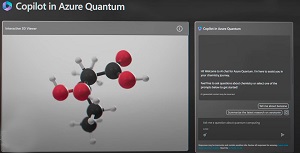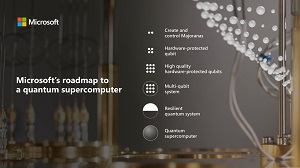News
Microsoft and Google Advance Quantum Computing While AI Hype Rages
Generative AI may be dominating the tech hype cycle these days, but amid the hoopla Microsoft and Google have been making advances in another mind-boggling future technology: quantum computing.
While too technical to explain here, quantum computers can hopefully one day drastically outperform traditional computers -- on a variety of levels -- by leveraging laws of physics exhibited in extremely small and low-temperature environments or systems. They are expected to be much more capable and faster while at the same type requiring less power and improving security.
After years of research, quantum-themed announcements from cloud giants Microsoft and Google seemed to have recently picked up the publication pace. For example, just last month Microsoft announced new advances to its Azure Quantum project aimed at accelerating scientific discovery.
In claiming that the industry is fast approaching a time when the tech can solve previously intractable problems to unlock growth and human progress, Microsoft announced the following three advances in Azure Quantum related to that vision.
Azure Quantum Elements
This is a new system designed to accelerate chemical and materials science.
Azure Quantum Elements accelerates scientific discovery by integrating the latest breakthroughs in high-performance computing (HPC), AI and quantum computing.
Microsoft said it will help scientists and product developers to:
- Reduce time to impact and costs by accelerating the R&D pipeline and bringing innovative products to market more quickly, with some customers seeing a six-month to one-week speed up from project kick-off to solution.
- Dramatically increase the search space for new materials, with the potential to scale from thousands of candidates to tens of millions.
- Speed up certain chemistry simulations by 500,000 times, which is like compressing a year into one minute.
- Get ready for scaled quantum computing by addressing quantum chemistry problems today with AI and HPC, while experimenting with existing quantum hardware and getting priority access to Microsoft's quantum supercomputer in the future.
Copilot in Azure Quantum
This helps scientists use natural language to reason through complex chemistry and materials science problems. It joins a raft of copilot assistants that Microsoft is infusing throughout a broad swath of its software, even its flagship Windows OS. The copilot term was borrowed from the original GitHub Copilot "AI pair programmer" introduced much earlier by Microsoft-owned GitHub.
 [Click on image for larger view.] Copilot in Azure Quantum (source: Microsoft).
[Click on image for larger view.] Copilot in Azure Quantum (source: Microsoft).
"With Copilot in Azure Quantum, a scientist can accomplish complex tasks on top of a fabric of cloud supercomputing, advanced AI and quantum all integrated with the tools they use today," Microsoft said. "It can generate the underlying calculations and simulations, query and visualize data and help get guided answers to complicated concepts. Just as Copilot in other Microsoft products is transforming software development, productivity and search, our ambition is for Copilot in Azure Quantum to transform and accelerate scientific discovery -- whether it's creating safer and more sustainable products, accelerating drug discovery or solving the most pressing challenges on the planet."
Microsoft's Roadmap to a Quantum Supercomputer
Microsoft predicts that as quantum computing advances, its hardware will fall into one of the following three Quantum Computing Implementation Levels:
- Level 1 -- Foundational: Quantum systems that run on noisy physical qubits, which includes all of today's Noisy Intermediate Scale Quantum (NISQ) computers.
- Level 2 -- Resilient: Quantum systems that operate on reliable logical qubits.
- Level 3 -- Scale: Quantum supercomputers that can solve impactful problems that even the most powerful supercomputers cannot.
 [Click on image for larger view.]Microsoft's Roadmap to a Quantum Supercomputer (source: Microsoft).
[Click on image for larger view.]Microsoft's Roadmap to a Quantum Supercomputer (source: Microsoft).
Microsoft further claimed it has achieved a breakthrough: the first milestone toward a quantum supercomputer, as detailed in peer reviewed data in a journal by the American Physical Society.
"We can now create and control Majorana quasiparticles," Microsoft said. "With this achievement, we're well on our way to engineering a new hardware-protected qubit. With it, we can then engineer reliable logical qubits to reach the Resilient Level and then progress to reach Scale."
Google and Quantum Supremacy
Google famously claimed in 2019 that it had achieved "quantum supremacy" using a programmable superconducting processor. A 2018 post exploring "The Question of Quantum Supremacy" explains the concept: "An important goal in the pursuit of a universal quantum computer is the determination of the smallest computational task that is prohibitively hard for today's classical computers. This crossover point is known as the 'quantum supremacy' frontier, and is a critical step on the path to more powerful and useful computations."
This week, Google discussed another quantum computer breakthrough with "The Telegraph," which reported, "Google has developed a quantum computer that instantly makes calculations that would take the best existing supercomputers 47 years, in a breakthrough meant to establish beyond doubt that the experimental machines can outperform conventional rivals." While the preceding link points to a 2020 article, the technical details are included in a an April scientific paper titled "Phase transition in Random Circuit Sampling."
"Quantum computers hold the promise of executing tasks beyond the capability of classical computers," said the paper, which went on to say, "We estimate the computational cost against improved classical methods and demonstrate that our experiment is beyond the capabilities of existing classical supercomputers."
Google in May announced another advancement in the post "An important step towards improved quantum computers" that revealed the world's first observation of non-Abelian braiding, which is too technical to discuss here but which is fully explained in the article, "Non-Abelian braiding of graph vertices in a superconducting processor" published in May by Nature.
Google has been active on the quantum computing front, also publishing recent posts including:
Stay tuned for more news from Microsoft, Google and others as quantum computing advancements are made.
About the Author
David Ramel is an editor and writer at Converge 360.